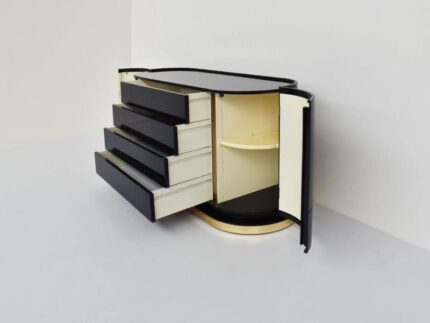Pair of silvered bronze cups, chased by Désiré Attarge after an antique model (Ist Century), known as the Coupe d’Alésia or Canthare d’Alise-Sainte-Reine (now preserved at Antiquités Nationales Museum, Saint-Germain-en-Laye).
The archaeological excavations led in Alise-Sainte-Reine (Côte-d’Or, France) were commissioned from 1861 until 1865 by His Majesty the Emperor Napoléon III in order to find back the place of the Alesia Siege, led by Caesar against Vercingétorix. As soon as 1866, F. Barbedienne was allowed by the emperor to make a replica of that cup for the Dijon Museum, as well as to reproduce it for his own clients (Coignard, “Agapes impériales”, L’objet d’art, juin 1987, p. 30-41). Nowadays, some pieces are known, such the one exposed at the Château de Compiègne or another one presented at the famous Orsay Museum.
One of those cups was presented at the 1878 Paris Universal Exhibition on F. Barbedienne’s stand, where his silvered works after antiques were more appreciated than his common other bronze pieces, which were however very successful.
Born in 1810, Ferdinand Barbedienne started at n°30 boulevard Poissonnière in Paris one of the most famous 19th century artistic bronze casting companies. He died in 1892. In addition to his personal production, he worked for famous artists such as Auguste Clésinger, Albert-Ernest Carrier-Belleuse and Louis Barrias. At the London Universal Exhibition of 1851, Barbedienne’s firm won two “Council medals”. At the 1855 Universal Exhibition, he won a medal of honour and eleven cooperator’s medals for the work of his co-workers, such as his model designer Louis-Constant Sévin (1821-1888) and his chaser Désiré Attarge (circa 1820-1878). D. Attarge won also the Crozatier Prize in 1862 and 1864, which was awarding the France best chaser, and was once again awarded at the 1867 Universal Exhibition with a Silver medal as Barbedienne’s co-worker. Jury’s report was then very explicit : “It’s impossible to show more taste in composition and more maestria in the making of these leaves and elegant flowers, all chased with so extreme delicacy”. The success of Barbedienne’s firm brought him many official commissions, such in circa 1860, as Barbedienne supplied bronzes for furniture for the Pompeian Villa of Prince Napoleon, located avenue Montaigne in Paris. Barbedienne’s production was always highly esteemed and he was, himself admired by contemporary art critics who compared him during the 1878 Universal Exhibition to a “prince of industry and the king of bronze-casting”. His glory did not decline with the passage of the time for at the Universal Exhibition of 1889 the critics thanked Barbedienne for the example he set for other bronze-casters by the perfection of his bronzes.
-
Creator:Désiré Attarge(Metalworker),Ferdinand Barbedienne(Manufacturer)
-
Dimensions:Height: 4.34 in (11 cm)Width: 7.49 in (19 cm)Depth: 4.34 in (11 cm)
-
Sold As:Set of 2
-
Materials and Techniques:BronzeSilvered
-
Place of Origin:France
-
Period:1870-1879
-
Date of Manufacture:circa 1878
-
Condition:GoodWear consistent with age and use. Minor fading.
-
Seller Location:PARIS, FR
-
Reference Number:Seller: 889/0Seller: LU3860313527142































Reviews
There are no reviews yet.